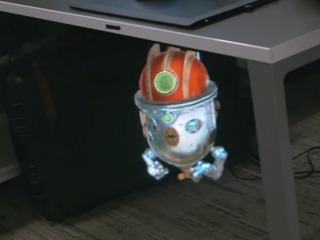Joe Murad, the new CEO of Vida Health, talks about his vision for the company
Murad was appointed last week, succeeding founding CEO Stephanie Tilenius
Read more...For a long time, Magic Leap remained one of the best held secrets in tech, with no one really knowing what the company did even while it raked in bundles of cash at huge valuations. It wasn't until 2017 when the technology was finally unveiled to the world and it wasn't until earlier this year that its first product finally went on sale.
Needless to say, the company and the technology are both still in their earlu stages, but that only makes it more exciting. The applications for its technology, which allows users to place 3D computer-generated imagery over real world objects, are wide open, and it can revolutionize any number of different sectors.
That includes healthcare, which is why the company formally announced on Wednesday the hiring of Jennifer Esposito as its Vice President of Health.
Prior to joining Magic Leap earlier this year, Esposito worked for over 13 years at GE Healthcare before becoming General Manager of the Health and Life Sciences group at Intel Corporation, where she worked for over four years.
Esposito has received a patent for an industrial internet of things system and method for capturing radiation exposure data from medical imaging equipment and drove the development of industry-first products and capabilities that used advanced and predictive analytics. She was also the co-chair of the Global Health Security Agenda Private Sector Roundtable and chairs their Work Group on Technology and Analytics, while also serving as the co-chair of the Work Group on Digital Health and Non-Communicable Diseases as part of the Broadband Commission for Sustainable Development. Eposito sits on the boards of Digital Square and USA Healthcare Alliance.
Sh has a graduate degree from the Dartmouth Institute for Health Policy and Clinical Practice at Dartmouth College where she focused on Epidemiology and Biostatistics and also spent several years working in academic medical research on skin and bladder cancer.
Magic Leap has made a number of partnerships in the healthcare space already, including one with medical device company Brainlab, therapeutic platform XRHealth and neuro-technology platform SyncThink. Eposito spoke to me about some of these initiatives, what made her want to join Magic Leap, and how she believes the company's technology will help transform healthcare.
VatorNews: You’ve been with Magic Leap since January. Tell me why you chose to join the company in the first place. What attracted you to this position?
Jennifer Esposito: Magic Leap is a company that’s been developing a platform called spatial computing, and you probably saw the announcement last August about the release of our first product, which was a developer edition called the Magic Leap One. The company has had a team working on health for quite some time, so it predates me for sure, and one of the interesting things for me about the opportunity was just to work on a team that has been part of this for quite some time. We have some history with our CEO also having come from the med device background, so that was part of the DNA of the company and some of the people on the team.
I’m really excited to be working on developing out the use cases, and building the ecosystem around the platform in the health industry. We’re looking at all different sorts of use cases from the hospital to the clinic and into the home, so patient-worn and physician-worn use cases are things that are really interesting to us and that’s what really excited me and got me interested in joining.
VN: What have you learned in this role since you started? What surprised you about the spatial computing space?
JE: What’s really interesting here about spatial computing is it comes at a time when we’re going to be able to leverage things like AI and IoT and 5G, which is also really interesting too at this time because it’s going to enable some of the use cases that we’re talking about. So, spatial computing is a really interesting and important use case for things like 5G. Once you couple that with these other technologies, like AI and IoT, you have a really interesting opportunity to put all this technology together that we’ve been talking about for years but, for the most part, haven't really been capable of until recently.
When we talk about spatial computing we often talk about the fact that it's a new computing platform that represents this convergence of communication technologies and technologies that are about computing, but also new ways of computing, where you can actually bring the physical world and the digital world together.
VN: How do you think spatial computing will transform healthcare? Can you go deeper into some of those use cases you mentioned?
JE: Let’s talk about the hospital first; we announced last year a partnership with a company called BrainLab that does surgical navigation. What we’ve been working on with them is a platform, we’re calling it a "software development framework," which will enable other med device companies in the ecosystem to more easily build on the Magic Leap platform, but also leverage certain tools and capabilities that we’re going to jointly develop with BrainLab. The intention here is to use spatial computing to enhance or augment how we conduct surgery, so the first products that we’ll launch are focused on surgical planning. You’ll see stuff coming later this year from us that will take 2D planning into a 3D spatial environment and allow for collaboration in ways you couldn’t do before. There’s definitely a lot here, even in the early stages, that focuses on 3D spacial visualization and new and interesting ways to both combine different types of data, but also to make it easier to understand, make complex data easier to understand. When you put it into a 3D environment you’re able to walk around and remove layers, things like that. We’ll continue to work with BrainLab on other use cases into the future that really talk about how we can really create a true digital operating room of the future.
VN: You’ve been partners with BrainLab since last October, so have you been able to calculate any ROI so far?
JE: We haven't released the first products yet, so that will come later. The partnership was announced last year and we’ve been working since then on join development. The initial product that will be released at some point later this year is going to focus on surgical planning, so not in the operating room quite yet.
VN: Magic Leap has also partnered with XRHealth and SyncThink. What does each side get from those partnerships?
JE: SyncThink is a really great example of how we have been partnering early with companies and entities that are working on developing different biomarkers. There are a number of different sensors on the device that are there for other purposes that we are working on clinical validation, so that they can potentially be used to monitor different biological functions or medical tests. SyncThink is a really good example because they have a lot of experience in things like detection of concussions and other neuropsychological conditions, so we’re working with them and they’re trying to convert the tests that they’re currently doing into this platform.
XRHealth is working on a variety of different solutions. They have some solutions that currently exist today for different types of therapies. Again, this is a company that’s very early in starting to work on the platform and develop different solutions. A lot of what my team and I are focused on is building out this ecosystem of potential developers. So, if you look at what we’re doing with BrainLab, and some of the work we’re doing on the biomarkers with companies like SyncThink, it’s building a variety of different platform tools that people can use to develop on top of and make the ecosystem relatively open in terms of being able to access those tools.
VN: How far along are we and how much further do we have to go before this technology becomes ubiquitous in healthcare?
JE: It’s definitely early on. Everybody on our team is focused on helping build these tools because it is early on and we want people to be able to use the platform more easily, have access to different capabilities and tools so that we can start to test out these use cases that we all think are going to be exciting and possible in two to five years or so.
VN: What’s exciting for you in healthtech right now? In general, what do you see as the future of the space?
JE: It’s a little bit of what I talked about earlier with respect to all of these technologies starting to become mature enough at the same time. So, this convergence of spatial computing and AI and IoT and even the 5G networks that are going to be available, those things together are going to enable some of these things. When I started working at Intel we were talking about telemedicine and virtual care a whole lot, but even four or five years afterwards it was still not really a reality, and only now are we starting to see the potential that these technologies are going to allow things like telemedicine to take off. That’s why this is pretty exciting because it is a point in time where I think the technology is finally ready. It requires more than one thing; it’s not just the wearables, it’s not just connectivity or speed, it’s all these things together.
VN: As you mentioned, it took telehealth all these years to become mainstream, so will it take less time for spatial computing to do the same because telemedicine and those technologies are already mainstream?
JE: That’s exactly the key here. It’s a question of the fact that there’s this point in time where many, many things are coming together. When we started to talk about telehealth there was a lot of discussion about IoT, and we were starting to see wearables coming into the picture. What we’re seeing now is the fact that all of these things are happening now will allow all of this stuff take off that we’ve been waiting for. I always bring up telehealth as an example because it’s one of those things that we were waiting for, waiting for, waiting for, and then it’s finally emerged.
VN: How long will it be before spatial computing is mainstream within healthcare? When do you see that happening?
JE: I really think we’re going to start to see some interesting use cases certainly with things like surgical planning and data visualization, we’re going to see these use cases come into play pretty soon. Then they’ll get gradually more complex and more integrated into clinical care over the course of the next two or five years or so.
VN: What’s beyond that? If this will be mainstream in five years than what’s in 10 years? What’s your vision for healthcare?
JE: I don’t know if you’ve seen some of the things we’ve done around the Magicverse and other elements of the platform that Magic Leap is developing, but with spatial computing and 5G together, we have the ability to create digital twins of locations and spaces. In our case, think of a digital of a hospital or an operating room, and the ability to understand how objects move within that space. The ability to use AI to understand that movement, to optimize workflows, to augment the work of physicians, there’s some really interesting possibilities there.
What it really does enable, also, is expanding access to care because you’re not going to be constrained necessarily by geography anymore. With the ability to bring in experts from all over and consult on different clinical cases that might be more complex, you’ll have access to specialists that are the right person for the specific issues that a person might have at that point in time. It’s really about breaking down some of the boundaries that geography presents today, expanding access and giving people that are working in clinical fields more tools to augment their work.
VN: What is the ultimate goal for healthcare at Magic Leap? What would success look like for you?
JE: I’d really like to see a very robust ecosystem of people developing spatial computing and linking those other technologies. That, for me, would be the way the team would look at success in the next two or three years or so.
VN: Is there anything else I should know? Or is there anything we talked about that you want to make sure people understand?
JE: I definitely want to underline the part around building out the developer and the partner and solution ecosystem that’s out there, so people can take advantage of both our spatial computing platform but also the other technologies I mentioned. Then, what I said about the foundational elements of things like Magicverse to expand access to care and think about how that breaks down barriers is important. Those two things together are pretty exciting and those are those are the things that got me excited in the first place.
Register for Vator's Reinventing the Doctor even on Sept. 12 at UCSF. Speakers include Keith Rabois, Partner at Founders Fund; Dr. Sunita Mishra, CEO of Providence Express Care; Dr. Michael Abramoff, CEO of IDx; Dr. Arif Nathoo, CEO of Komodo Health and more. REGISTER HERE.
Murad was appointed last week, succeeding founding CEO Stephanie Tilenius
Read more...Noah Medical, which has developed a robotics system for detecting lung cancer, recently raised $150M
Read more...The company just announced a $22.5 million round, bringing its total funding to over $43 million
Read more...

